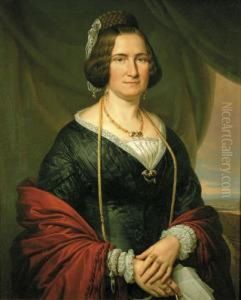Carl Anthon Schmidt Paintings
Carl Anthon Schmidt was a Danish painter born in 1835, in a period when Denmark was undergoing significant transformations, both socially and culturally. His life and career spanned much of the 19th century, a time when art was evolving rapidly, with new ideas about realism, naturalism, and the role of art in society coming to the forefront. Schmidt was part of this vibrant artistic milieu, contributing his unique perspective and talents to the Danish art scene.
Schmidt's early life and education in art laid the foundation for his later work. Like many artists of his era, he was initially trained in the traditional academic style, which emphasized classical themes, meticulous technique, and a polished finish. However, as he matured as an artist, Schmidt began to incorporate more realistic and naturalistic elements into his work, reflecting broader trends in European art. His subjects often included landscapes, scenes of daily life, and occasionally, portraits, all rendered with a keen eye for detail and a deep sensitivity to the nuances of light and color.
Throughout his career, Schmidt exhibited his work widely, both in Denmark and abroad, gaining recognition for his skillful execution and his ability to capture the essence of his subjects. Despite this, he never achieved the same level of fame as some of his contemporaries, such as the Skagen Painters, a group of Danish artists who gathered in the northern village of Skagen to paint the unique light and landscape. Nevertheless, Schmidt's contributions to Danish art were significant, and his works are still appreciated today for their beauty and craftsmanship.
Carl Anthon Schmidt passed away in 1908, leaving behind a body of work that continues to be studied and admired. His paintings are held in several Danish museums, where they stand as testament to his skills and his dedication to his art. In the context of Danish art history, Schmidt is remembered as a talented and versatile painter who navigated the shifting currents of 19th-century art with grace and originality.
